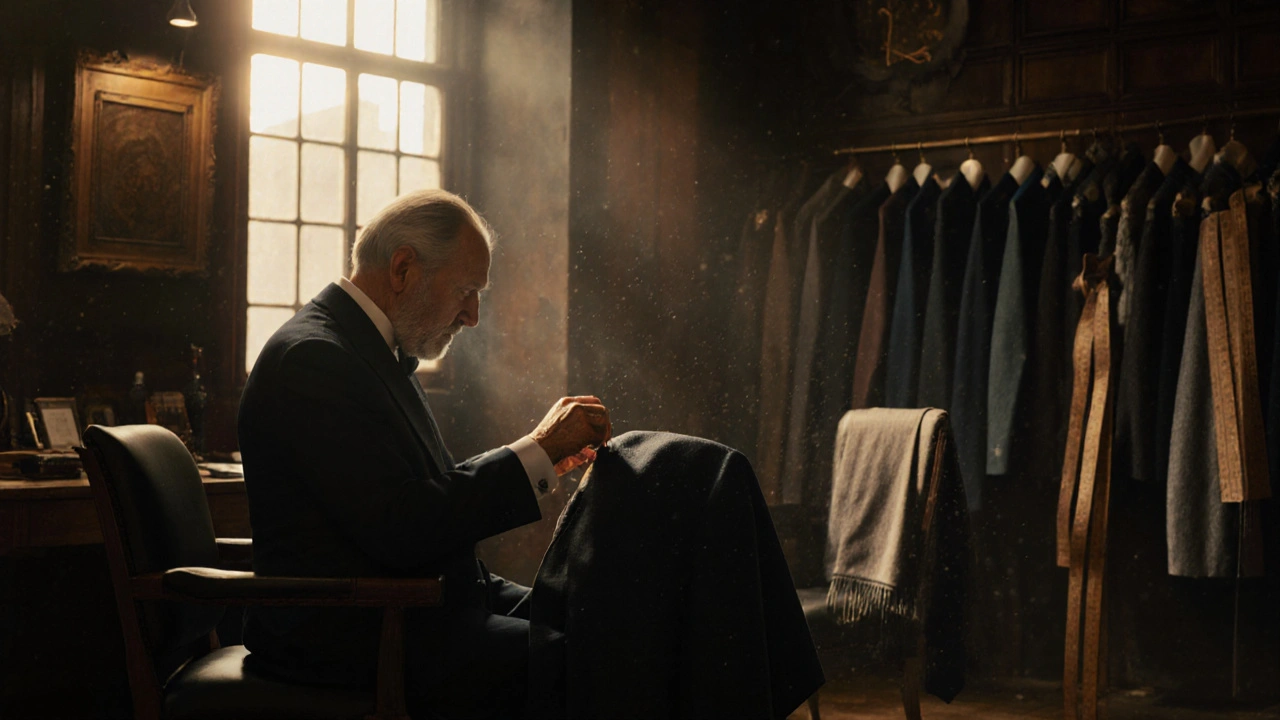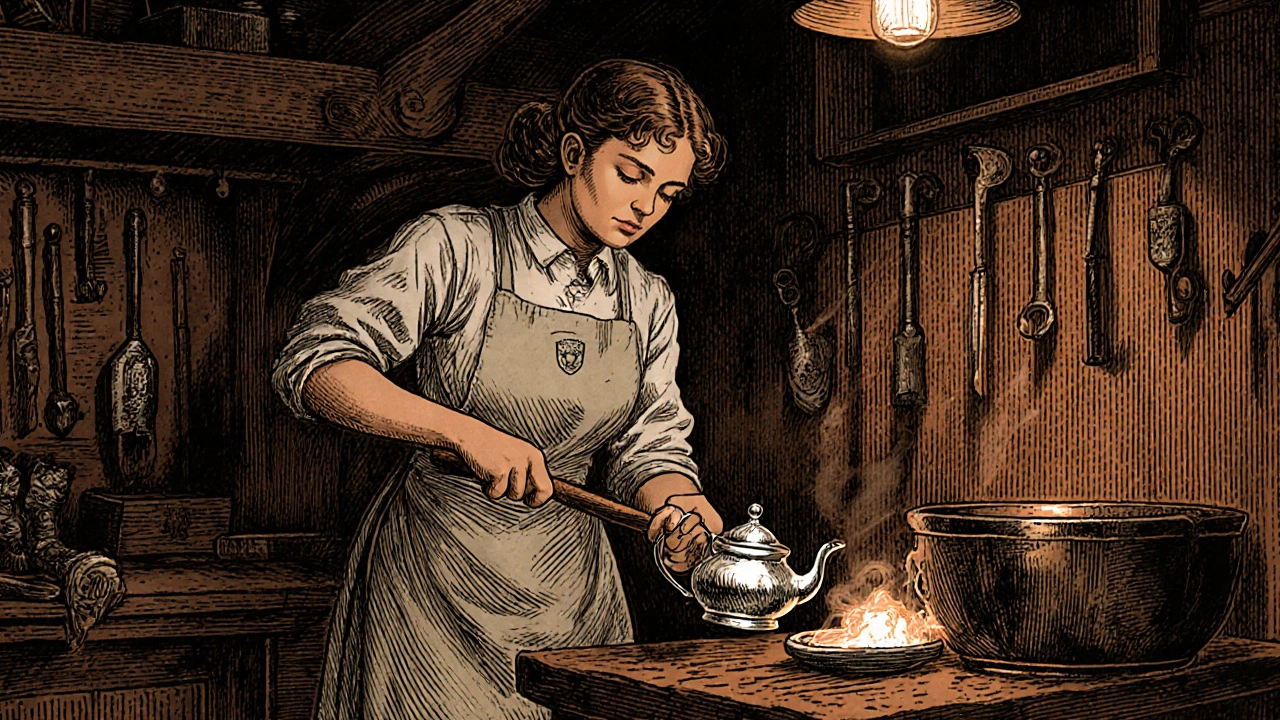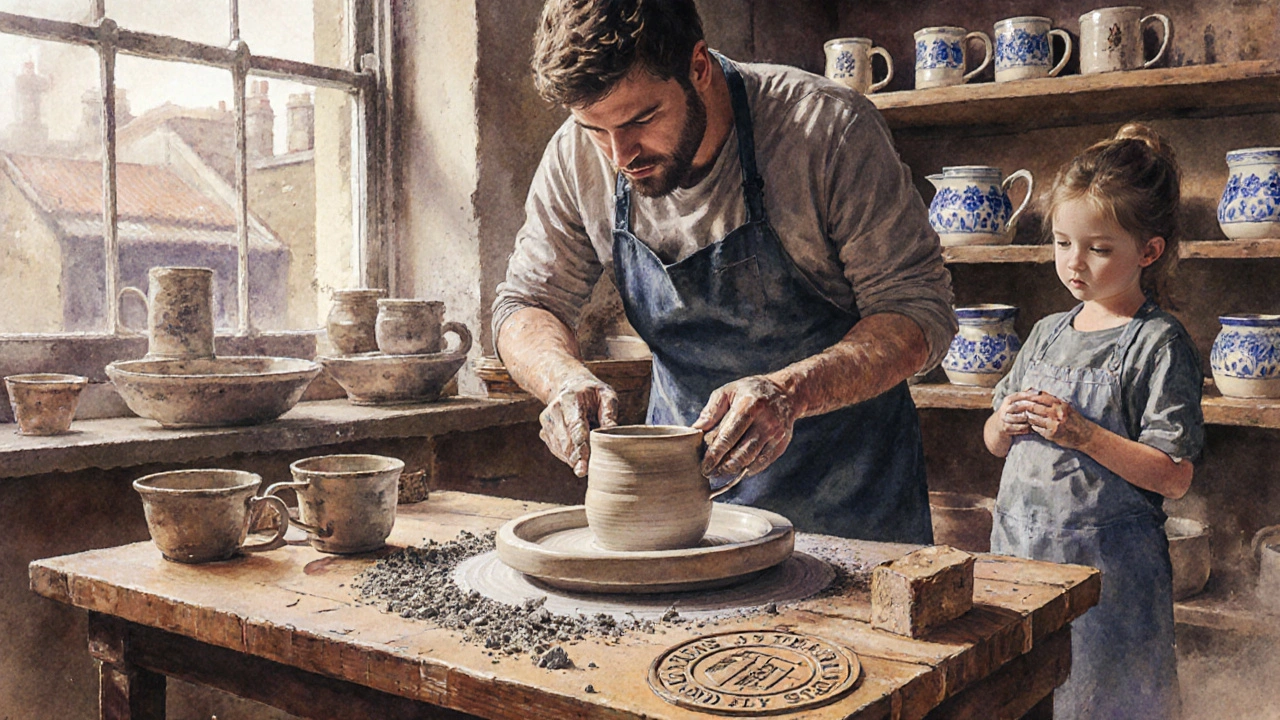
Walk through the backstreets of London’s West End and you’ll hear the quiet clink of hammers on silver, the rhythmic pull of a needle through wool, and the whisper of clay spinning on a wheel. These aren’t museum exhibits. They’re living trades-passed down for generations, kept alive by a small but stubborn group of makers who refuse to let tradition fade. In a city full of fast fashion and mass-produced goods, London still holds onto its heritage crafts: tailoring, silverwork, and ceramics. Each one carries a story, a skill, and a soul.
Where the Suit Was Born: London Tailoring
When you think of a perfect suit, you’re probably thinking of Savile Row. It’s not just a street-it’s a standard. Since the 18th century, tailors here have shaped the way the world dresses. The secret? No machines make the final stitch. Every suit is cut by hand, fitted over multiple appointments, and stitched with a needle that’s been in the same family for decades.
At Gieves & Hawkes, founded in 1771, apprentices still spend seven years learning the craft. They start by folding linings, then move to basting, then hand-sewing buttonholes-one at a time, each taking 20 minutes. A single bespoke suit can take 80 hours to complete. That’s not luxury for show. It’s precision. The lapel roll? Shaped by the tailor’s fingers over weeks. The shoulder? Contoured to the wearer’s posture, not a template.
These tailors don’t just make clothes. They archive bodies. One client, a retired diplomat, has worn suits from the same tailor since 1968. His measurements haven’t changed much, but his life has. The suit remembers him better than his passport does.
Silver That Speaks: The London Assay Office and Beyond
Look closely at a vintage tea set or a modern engagement ring in London, and you’ll likely find a tiny hallmark: a leopard’s head. That’s the mark of the London Assay Office, established in 1327-the oldest in the UK. It’s not just a stamp. It’s a promise. The silver has been tested, verified, and stamped by hand in a building on Fleet Street that’s been doing this for nearly 700 years.
Modern silversmiths like Sarah Bland work in tiny workshops near Clerkenwell, hammering out candlesticks and bowls using techniques unchanged since the Victorian era. She melts down old spoons, pours the molten silver into ingots, then rolls it thin by hand. Every curve is shaped with a mallet and stake, not a press. The surface isn’t polished to a mirror shine-it’s left with the soft, uneven texture of human touch.
What makes London silver special isn’t just the purity. It’s the story behind each piece. A 1920s cigarette case might have been engraved for a soldier returning from the trenches. A 1970s goblet might have been gifted at a wedding in Notting Hill. The silver carries memory. And unlike plastic or stainless steel, it ages gracefully-darkening, then polishing back to life with a little care.

Clay with a London Accent: Ceramics in the City
Most people think of Stoke-on-Trent when it comes to British ceramics. But London has its own quiet legacy. In places like Hackney and Southwark, potters are reviving the city’s lost glazes and forms. The London Clay, once dug from the banks of the Thames, was used for everything from sewer pipes to teacups in the 1800s. Today, makers like James O’Hara are recreating those original recipes.
O’Hara’s studio sits above a former Victorian bakery. He mixes local clay with crushed flint and wood ash, then fires it in a gas kiln at 1,280°C. His mugs have a rough, earthy feel-unlike the smooth, mass-produced ones you find in chain stores. He doesn’t sign them. Instead, he stamps each piece with a small, hand-carved seal: a stylized Thames barge. It’s a nod to the city’s waterways, and the boats that once carried clay from Kent to London’s kilns.
Some of his pieces are inspired by 18th-century London delftware-the blue-and-white pottery once sold on street corners. Back then, it was affordable. Now, it’s rare. O’Hara’s goal isn’t to copy history. It’s to keep the conversation alive. He teaches weekend classes to students who’ve never touched clay before. One 16-year-old from Peckham made a bowl shaped like a Tube station sign. It’s not perfect. But it’s hers. And that’s the point.
Why These Crafts Still Matter
You might ask: why bother? Why spend weeks on a single suit when you can buy one for £150 online? Why hand-hammer silver when a machine can do it in minutes? The answer isn’t nostalgia. It’s survival.
These crafts are a counterweight to disposable culture. A bespoke suit lasts 20 years. A hand-thrown mug doesn’t chip after three washes. A silver teapot becomes an heirloom. They’re investments in time, not just money.
There’s also a quiet rebellion here. In a world where algorithms decide what you like, these makers still listen to hands. They notice how someone holds a cup. How their shoulders slump when they sit. How their fingers tremble slightly when they’re nervous. That’s not data. That’s humanity.
And it’s working. Younger people are starting to care. Not because it’s trendy, but because it’s real. Instagram doesn’t sell these pieces. Word of mouth does. A tailor’s client tells a friend. A silversmith’s customer passes on a teapot to their daughter. A potter’s student opens a stall at the Broadway Market. The chain keeps going.

Where to Find Them Today
If you want to see these crafts in action, don’t just shop. Go watch.
- Savile Row: Book a consultation at Henry Poole or Huntsman. Ask to watch the fitting. Most will let you sit in the back room while the tailor works.
- London Assay Office: Tour their historic building on Fleet Street. You can even watch them test silver in real time.
- Ceramic studios: Visit the London Craft Week in October. Or drop by Studio 100 in Hackney for open studio days.
- Markets: Columbia Road Flower Market on Sundays has a few stalls selling handmade ceramics. Brick Lane’s Sunday market sometimes features silver jewelry from independent makers.
Don’t go looking for a bargain. Go looking for a connection.
What’s at Risk
These crafts aren’t dying. But they’re thinning. The average age of a London tailor is 58. The next generation of silversmiths? Fewer than 30 in the entire city. Ceramic studios are closing because rent in East London doubled in five years.
It’s not just about money. It’s about time. Learning these skills takes years. No one gets rich doing it. And few young people are taught to value slow work over fast results.
But here’s the thing: you don’t need to become a tailor to help. Buy one handmade mug. Get one suit tailored. Gift a silver spoon engraved with initials. Support the makers who still use their hands. That’s how tradition stays alive-not in museums, but in use.
The next time you put on a jacket that fits like it was made for you, or drink tea from a cup that feels warm in your hands, remember: someone spent months making that happen. And someone, somewhere, is still learning how to do it right.
Are London heritage crafts still being taught today?
Yes, but not widely. Tailoring is taught at the London College of Fashion and through apprenticeships on Savile Row. Silverwork is passed down in small workshops, often through family lines. Ceramics are taught in community studios and at places like the City & Guilds of London Art School. However, funding is limited, and many programs rely on private donations or student fees to survive.
Can I buy authentic London-made crafts online?
You can, but be careful. Many websites sell mass-produced items labeled as "handmade." Look for maker names, workshop addresses, and hallmarks. For silver, check for the leopard’s head hallmark. For tailoring, ask for the tailor’s name and how many fittings are included. For ceramics, ask about the clay source and firing method. Reputable makers will answer these questions without hesitation.
Why is London silver different from silver from other places?
London silver is held to the strictest purity standard in the UK: 92.5% silver (sterling), tested and stamped by the London Assay Office since 1327. Other cities may use the same standard, but London’s hallmark system is the oldest and most trusted. The leopard’s head isn’t just a logo-it’s a guarantee of quality that’s been verified for centuries.
How much does a bespoke London suit cost?
Prices start at £2,500 and can go over £10,000 for top-tier tailors. The cost reflects the hours of handwork, the quality of fabrics (often from England’s West Country mills), and the multiple fittings required. It’s not just a suit-it’s a custom garment built to last decades.
Are there any free ways to experience these crafts in London?
Yes. The London Assay Office offers free public tours on weekdays. The Museum of London has rotating exhibits on traditional crafts. Some ceramic studios host open days where you can watch potters at work. And Savile Row tailors often let visitors peek into their workshops during business hours-if you’re polite and don’t take photos.
If you’ve ever held something made by hand-something that feels heavier, warmer, more real-you know why these crafts still matter. They’re not relics. They’re reminders. That not everything needs to be fast. That some things are worth the wait.